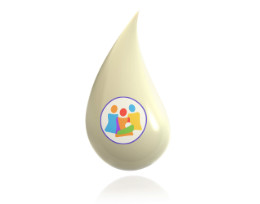Antenatal Hand Expression
Antenatal hand expression is removing colostrum from your breasts during the last month of pregnancy. There is growing awareness that this technique can support lactation early postpartum. Colostrum that is hand expressed and stored during the end of pregnancy can be used to supplement those newborns who need extra calories early postpartum. More studies are needed to identify the risks and benefits of this technique and to identify populations that may benefit from using it. If you plan to use this technique, speak with your obstetrical physician or midwife to ensure that it is safe for you and your baby.
What are possible benefits of antenatal hand expression?
- Storing colostrum to use if your baby needs supplementation after birth. The colostrum expressed during pregnancy can be brought to the hospital and given to your newborn if the hospital staff recommend supplementation because of the need for extra calories. The most common reason for newborns to need supplementation is low blood sugar, particularly if the mother or birthing parent has a history of diabetes or gestational diabetes.
- Antenatal hand expression can help you learn a valuable skill in case you need to hand express your colostrum or milk after your baby is born for one or more of the following reasons:
-
- Expressing colostrum early on if you and your baby are separated.
- Expressing colostrum after feeds to promote an increase in milk production. It takes longer for milk production to rapidly increase in some people, such as those with gestational diabetes, cesarean birth, pre-eclampsia, and other medical conditions.
- Feeling engorged with a need to remove a small amount of milk for comfort or to help latch.
When should I start antenatal hand expression, how often, and how much?
Always check with your obstetricial physician or midwife prior to starting antenatal hand expression to ensure this technique is safe for you and your unborn baby. Generally, this should be started at or after 36 weeks, and performed no more than twice a day, for no longer than 10 minutes each time. Many people express very little colostrum each time, often none or a few drops.
How do I hand express?
Check out this UNICEF video on how to hand express. This video discusses hand expression after delivery, but the technique is similar when expressing milk before your baby is born. Below are the steps:
- Collect the supplies needed to hand express. These include:
-
- A heating pad or other means of warmth, to help promote colostrum flow prior to hand expressing.
- A small bowl, plate, or cup to express the colostrum into.
- Small syringes, approximately 1-3ml, to draw up the drops. The drops can be stored in the syringes.
- A container, such as a ziplock bag, for storage of the syringes containing with colostrum.
- Get ready: find a comfortable place to sit, apply heat to your breasts for a few minutes, and take a moment to relax and clear your mind before starting.
- Massage: Gently touch your breasts before hand expression. Tickling or light petting of the breasts can help to increase colostrum flow. Avoid nipple stimulation, which can increase the chances of uterine contractions.
- Hand express:
-
- Make a c-shape with your hand and cup your breast a few inches away from your nipple.
- Compress the breast tissue with your thumb and index finger (make sure you are not near the nipple and are on the breast tissue, and then release. Allow droplets of colostrum to collect in your small container.
- After a few minutes repeating a and b, rotate your hand so that you are expressing a different region of the breast.
- Use a small syringe to collect the colostrum.
- Label the syringe with your name and the date of colostrum expression.
- Freeze the syringe if you do not anticipate using the colostrum in the next 3 days.
What if I cannot express any colostrum?
Many women have difficulty expressing drops of milk during pregnancy. This does not mean anything about the ability to produce a sufficient amount of milk postpartum.
Will my baby not get colostrum if I do this?
During pregnancy, your hormones maintain continued production of colostrum and prevent transition to full milk production. More colostrum will be produced right after birth. The shifts in your hormones that occur after birth gradually trigger full milk production.


